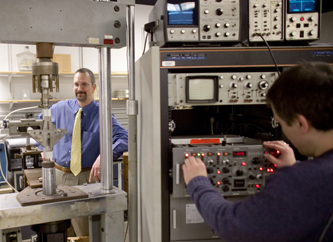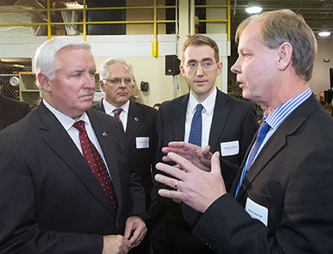A revolution, one layer at a time
Much as the Internet has transformed commerce and communications, 3D printing, or additive manufacturing, may revolutionize industry by making it possible to make products in a home or office, rather than a factory.
A 3D printer produces an object by laying down successive layers of material in different shapes. 3D printing is now used to create lighter airplane parts, aerodynamic car bodies, custom prosthetic devices and more.
Martin Harmer and Ray Pearson, professors of materials science and engineering, are evaluating the use of ceramic nanoparticles to enhance the mechanical and electrical properties of powder-based polymers that are used in selective laser sintering (SLS), a rapid 3D printing method. They collaborate with Paramount, a Pennsylvania company, to improve plastic parts made with 3D printing. The project is funded by the Research for Advanced Manufacturing in Pennsylvania program (RAMP).
Most methods of feeding material into a 3D printer create products that are strong from front to back (X axis) and from side to side (Y axis). In making the sole of a sneaker, however, weakness in the Z axis (top-to-bottom) causes the layer-by-layer technique to result in a weaker sole than a sole made conventionally.
An SLS machine uses a pulsed laser to fuse powdered material into 3D shapes. This allows the powder to be preheated, which produces denser material. Another advantage is that it does not require molds or other support structures because the product being made is surrounded by unsintered powder.
SLS can be scaled up to produce large parts, but a limited number of materials can be used in the SLS process. One—the polymer Nylon 12—has attractive mechanical properties but its applications are limited by poor thermal and electrical conductivity.
In their experiments with Nylon 12, Harmer and Pearson add nanoparticles of silica and zinc oxide to the polymer using a slurry process. One challenge they face is achieving solid binding of the two materials at the surface.
“Our hypothesis is that this ceramic-coated polymer powder will absorb and retain more of the laser’s heat and thus allow for improved sintering,” says Pearson, who directs Lehigh’s Center for Polymer Science and Engineering. “Our goal is to develop nanocomposite materials that will exhibit improved mechanical, thermal and electrical performance.”
Undergraduates are learning to make materials atomistically in Lehigh’s new Genome Accelerated Materials Evolution (GAME) Lab, which is adjacent to a 3D printing facility.
"Students will be able to integrate computer modeling with rapid processing to develop materials more quickly,” says Harmer.
This October, Lehigh will host its ninth annual SPE Polymer Nanocomposites Conference.
Posted on:



